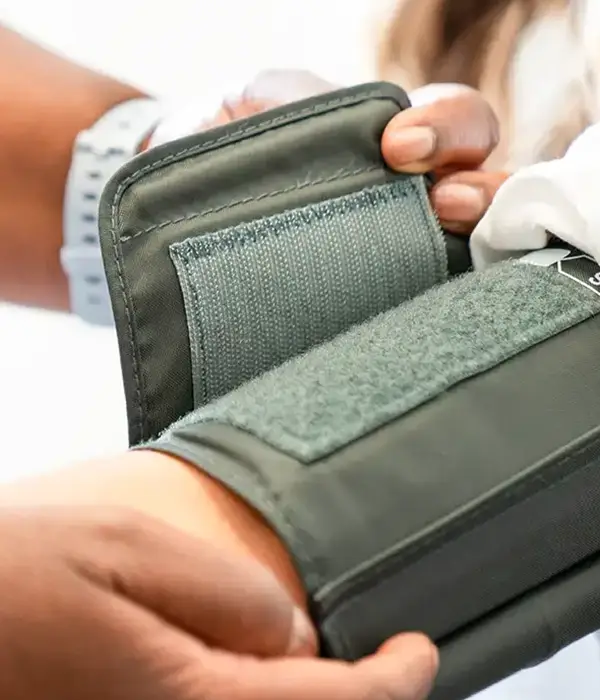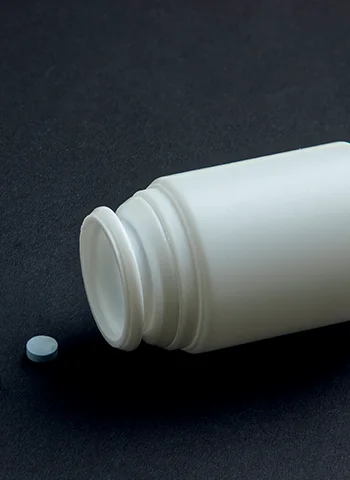Tapentadol Addiction Treatment
Tapentadol is often prescribed for pain relief, but for many people, its effects can come with hidden risks. What starts as a way to manage discomfort can sometimes spiral into dependence, affecting not just the body but also mental and emotional well-being.
Struggling with tapentadol addiction can feel isolating, yet recovery is possible. With the right opioid addiction treatment plan, you can manage withdrawal safely and begin building healthier routines for lasting change.

Take the First Step Towards Recovery
Steps Together offers personalised support and proven treatments, providing the care, guidance and encouragement you need to move forward with confidence and build a healthier future.

Understanding Tapentadol Addiction
Tapentadol is often prescribed to manage moderate to severe pain, including pain from injuries, surgery, and some chronic conditions. It binds to opioid receptors in the brain and spinal cord, which blocks pain signals. While it offers pain relief, tapentadol can cause serious side effects such as opioid use disorder, and it’s classified as a Schedule II controlled substance in the UK.
Additionally, tapentadol acts as a norepinephrine reuptake inhibitor. This means it prevents the chemical norepinephrine from being taken back up into nerve cells, helping to further block pain. This dual effect makes it different from traditional opioids like morphine.
Tapentadol Abuse and Dependence
Long-term or incorrect use of tapentadol can lead to addiction and dependence. When you take it regularly, your body may adapt and require larger doses to feel the same relief. This is called tolerance and can make you take more than prescribed.
Signs of tapentadol abuse and dependence may include taking tapentadol for reasons other than pain, using more than your prescribed dose, craving the medication or feeling unable to stop, and experiencing withdrawal symptoms if you suddenly stop taking it.


Risk Factors for Addiction
Like many opioids, tapentadol is addictive and can cause mental and physical dependence. Personal or family history of substance misuse is a major risk. People with mental health conditions, such as depression or anxiety, are also more vulnerable to misuse and dependence.
Chronic pain patients who use tapentadol for long periods, especially without regular medical monitoring, are at greater risk. Other risk factors include previous addiction to opioids or other substances, taking higher doses or combining tapentadol with alcohol or sedatives, and lack of support.
Tapentadol Addiction Treatment Options
Tapentadol addiction treatment usually combines medical, psychological, and social support. The most effective care plans address withdrawal, mental health, behaviour patterns, and relapse prevention. Professional help for tapentadol addiction includes:
Medical Detox
Medical detox is often the first step in stopping tapentadol use. This process must be supervised by medical professionals due to the risk of tapentadol withdrawal symptoms, such as anxiety, sweating, shaking, nausea, and insomnia.
Detox in a controlled setting allows staff to monitor your vital signs and intervene if complications arise. Medicines may be given to relieve discomfort and manage severe withdrawal symptoms. If you have other health or mental health problems, they can also be addressed during detox.
Therapeutic Interventions
Behavioural therapy is a core part of tapentadol addiction treatment. Cognitive behavioural therapy (CBT) helps you recognise and change patterns of thinking that lead to drug misuse. CBT may focus on stress management, drug refusal skills, and coping with triggers.
Other types of therapy, such as group counselling and one-to-one sessions, provide additional support. Family therapy can also be helpful if your home environment contributed to addiction. Many treatment centres offer a mix of these modalities, along with education about substance abuse.
Inpatient and Outpatient Rehabilitation
After detox, you may need further treatment through tapentadol rehab programmes. Inpatient rehabilitation provides 24-hour care in a residential setting, removing you from any triggers and giving close supervision. This is best if you have a severe addiction, need constant support.
Tapentadol can also be treated in outpatient settings. Outpatient rehabilitation lets you live at home while attending scheduled appointments for therapy and support. This option is more flexible, allowing you to maintain work and family responsibilities.
Aftercare
Aftercare helps you stay drug-free once formal treatment is finished. Support groups, like Narcotics Anonymous, offer regular meetings where you can share your experiences and receive encouragement from others in recovery. Staying connected to support networks lowers your risk of relapse.
You may also continue individual or group therapy and follow-up visits at addiction treatment centres. Many people benefit from a tailored aftercare plan that includes family support, practical help with work or housing, and regular drug testing.
Other addiction treatment services we offer

Preventing Tapentadol Misuse and Supporting Recovery
Preventing tapentadol misuse starts with knowledge. Managing medication safely, understanding the risks, and accessing support can reduce substance abuse and help you maintain progress in recovery. Using tapentadol safely begins with following your doctor’s directions closely.
Do not share your prescription or take medication meant for someone else. If you notice changes in your mood, behaviour, or physical health, mention this in your next appointment. Your provider may suggest starting with the lowest effective dose and reviewing your pain management plan regularly.
Holistic Approaches to Healing
Treating tapentadol addiction means caring for the whole person. Many people benefit from approaches that support mental, emotional, and physical health together. This can include mindfulness practices, yoga, nutrition counselling, or art and music therapy.
These therapies complement medical treatment by reducing stress, improving overall well-being, and giving you healthier ways to cope with difficult emotions. When combined with structured treatment, holistic care helps create a stronger foundation for lasting change.

Signs and Symptoms of Tapentadol Addiction
Dependence on tapentadol often develops over time, especially when the medicine is taken for longer than prescribed or in higher doses. A common sign is building up a tolerance, which means you need increasingly larger amounts of the drug to feel the same effect.
Some people may experience withdrawal symptoms between doses, which could include chills, yawning, muscle pain, or goosebumps. Psychological changes can also be significant. These may involve mood swings, sudden anxiety or depression, and irritability.
Behavioural signs of tapentadol addiction can be more obvious to those around you than they are to yourself. You might also notice yourself becoming isolated from family and friends or engaging in risky behaviours, such as driving while impaired. If your life begins to change in these ways, it might be time to seek help.
Health Effects and Dangers of Tapentadol Misuse
Tapentadol misuse can cause both short-term and long-term health issues that may range from mild symptoms to life-threatening conditions. You should understand these dangers so you can make informed decisions and recognise risks early.
Side Effects of Tapentadol
You may experience common side effects when taking tapentadol, especially if misused. These often include constipation, nausea, dizziness, and headache. Dry mouth is also frequent and may cause discomfort during daily activities.
Tapentadol increases the risk of severe side effects such as serotonin syndrome, especially when combined with other medicines affecting serotonin levels. Signs include agitation, sweating, confusion, or muscle twitching. Seek medical help immediately if these appear.
Respiratory and Nervous System Complications
Tapentadol misuse can seriously affect your breathing and nervous system. Respiratory depression, which means slow or shallow breathing, is a leading cause of death in opioid overdose.
Your risk increases if you already have lung problems or take tapentadol with other medicines that slow breathing. You may feel confused, sleepy, or weak if your nervous system is depressed. In severe cases, misuse can cause loss of consciousness, coma, or even death.
Risks Associated with Overdose
A tapentadol overdose can happen if you take more than prescribed or mix it with other substances. Signs of overdose include extreme drowsiness, slow breathing, limp muscles, and unresponsiveness.
Opioid overdose might lead to respiratory depression or even coma. Emergency treatment is vital because these effects can be fatal without quick intervention. Overdose risk rises if you relapse after a period of not using tapentadol or combine it with alcohol, sleeping pills, or other depressants.

We Offer Treatment for Tapentadol Addiction
The risk of addiction to opioids like tapentadol is significant, and the consequences can deeply impact all areas of life. However, recovery is absolutely possible with the right help. Tapentadol addiction treatment provides the tools, structure, and support needed to break free from opioid dependence.
At Steps Together, we want you to be free from addiction to tapentadol. With our drug rehab support, individuals can reclaim their health and wellbeing. While the journey may be challenging, it can also be deeply transformative and rewarding. Help is available, and recovery starts with reaching out.
Frequently Asked Questions
What are the signs of dependency on pain medication?
You may notice you need larger amounts of the medicine to get the same pain relief. Cravings, mood changes, and trouble stopping even when you want to can also be signs. Physical symptoms can include sweating, restlessness, or feeling unwell when you miss a dose.
What are the possible side effects of long-term tapentadol use?
Long-term use can cause several issues. These may include constipation, tiredness, confusion, trouble concentrating, and mood changes. Dependency and addiction may also develop. Some people notice their pain gets worse over time as their body adjusts to the medicine.
What are the risks associated with the withdrawal from tapentadol?
Withdrawal symptoms can range from mild to severe. You might experience anxiety, sleep problems, sweating, chills, muscle aches, or stomach upset. Detox should be managed by professionals to lower the risk and make the process safer and more comfortable.
How is tapentadol abuse effectively treated?
Treatment often begins with a safe detox, where doctors help you lower your dose slowly to manage withdrawal. Medicines and close medical supervision may be used. Professional treatment plans sometimes involve inpatient or outpatient rehabilitation programmes, which may include counselling, support groups, and regular check-ins.
Can counselling play a role in recovering from opioid addiction?
Counselling is very helpful for many people who want to recover from opioid addiction. You can talk to a trained professional about your thoughts and behaviour, learn safe coping methods, and get support for underlying issues. Counselling is often used together with other treatments and medical care.
Are there any non-pharmacological approaches to managing tapentadol addiction?
Yes, non-medicine options exist. You may benefit from therapies including cognitive behavioural therapy, mindfulness training, group support, and lifestyle changes like exercise or healthy eating. These options can be valuable tools in helping you stay free from addiction and build a healthier life.





